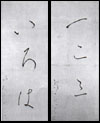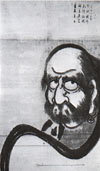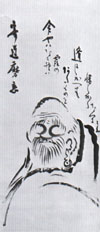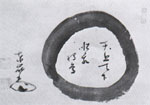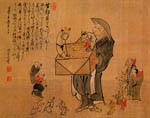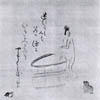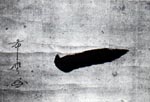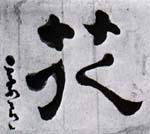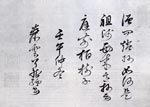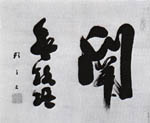"My play
with brush and ink
is not
calligraphy nor painting;
yet unknowing
people mistakenly think:
this is
calligraphy, this is painting."
Sengai
Gibon (1750-1837)
THE
APPRECIATION
OF ZEN ART
John Stevens
THE
EARLIEST reference to Zen brushwork occurs in the Platform
Sutra of the Sixth Patriarch, a text which relates the life and teaching
of the illustrious Chinese master Hui-neng (638-713). Buddhist scenes,
composed in accordance to canonical dictates, were to be painted on the walls
of the monastery in which Huineng was laboring as a lay monk. At midnight the
chief priest sneaked into the hall and brushed a Buddhist verse on the white
wall. After viewing the calligraphy the next morning, the abbot dismissed the
commissioned artist with these words: "I've decided not to have the walls
painted after all. As the Diamond Sutra states
'All images everywhere are unreal and false."' Evidently fearing that his
disciples would adhere too closely to the realistic pictures, the abbot
thought a stark verse in black ink set against a white wall better suited to
awaken the mind.
Thereafter,
art was used by Chinese and Japanese Buddhists to reveal the essence, rather
than merely the form of things, through the use of bold lines, abbreviated
brushwork, and dynamic imagery—a unique genre now known as Zen art.
Although
the seeds of Zen painting and calligraphy were sown in China, this art form
attained full flower in Japan. Masterpieces of Chinese Ch'an (Zen) art by such
monks as Ch'an-yueh, Liang K'ai, Yu Chien, Mu Ch'i, Chi-weng, Yin-t'o-lo and
I-shan 1-ning were enthusiastically imported to Japan during the twelfth and
thirteenth centuries and a number of native artists, for example Kao Sonen and
Mokuan Reiun, studied on the mainland. Building on that base, Japanese monks
such as Josetsu, Shubun, and somewhat later Sesshu Toyo and Ikkyu Sojun
produced splendid examples of classical Zen art; eventually Zenga became one
of the most important Japanese art forms, appreciated the world over for its
originality and distinctive flavor.
Early
Zen in Japan was a religion for cultured aristocrats and powerful fords but by
the fifteenth century Zen priests and nuns became actively concerned with the
welfare of common folk. The democratization of Zen had a marked effect on
painting and calligraphy, and the scope of Zen art was dramatically expanded.
Hakuin
and Sengai, the two greatest Zen artists, employed painting and calligraphy as
visual sermons (eseppo) to teach the hundreds of people, high and low,
that gathered around them. Both of the masters drew inspiration from other
schools of Buddhism, Confucianism, Shintoism, Taoism, folk religion, and
scenes from everyday life; their calligraphy too embraced much more than
quotes from the Sutras and Patriarchs—nursery rhymes, popular ballads,
satirical verse, even bawdy songs from the red-light districts could convey
Buddhist truths. Zen art thus became all-inclusive: anything could be the
subject of a visual sermon.
Following
the example of Hakuin and Sengai it became de
rigueur for Zen masters to do much of their teaching through the medium of
brush and ink; a tradition that continues to the present day. In many ways,
Japanese Zen art parallels the Tibetan Buddhist concept of termas
(hidden treasures).
According
to Tibetan legends, the guru Padmasambhava hid thousands of texts all over the
country to be discovered later when the time was ripe for their propagation.
Whether or not this is literally true, during the persecution of Buddhism in
Tibet during the ninth century, a large number of religious texts and articles
were in fact hidden in caves, under rocks, inside walls, and other secret
places to prevent their destruction, and over the centuries such treasures
were gradually recovered. Similarly in Japan during this century, devotees of
Zen art have uncovered thousands of magnificent pieces locked away in temple
store-rooms, sitting forgotten on shelves in private homes, kept in drawers by
indifferent art dealers, or left uncatalogued in museums. The illustrations in
this article are largely comprised of such discoveries. Significantly, these
pieces, some unseen for centuries but still bearing a message as fresh and
forceful as when first delivered, are reappearing just as it is possible to
display them throughout the world by means of modern print technology.
While
the primary purpose of Zen painting and calligraphy is to instruct and
inspire, it does have a special set of aesthetic principles; indeed, the best
Zen art is true, beneficial, and beautiful a combination of deep insight and
superior technique. The freshness, directness, and liveliness of Zen painting
and calligraphy imbue it with a charm that few devotees of Japanese art can
resist.
|
|
The aesthetics of Zen art are difficult to categorize. Zen artists follow the method of no-method and, in that sense, Zen painting and calligraphy is anti-art: not created for purely aesthetic effect and beyond the normal categories of beautiful or ugly. As an unadorned "painting of the mind" true Zen art is created in the here and now encounter of the brush, ink, and paper and if it has drips or splashes on it so much the better! Zen painting and calligraphy can also be thought of as folk art. |
|
One of the finest
examples of Zen calligraphy ever brushed (Figure 1) is a set of scrolls
written by Ryokan (1758-1831) for an illiterate farmer: i-ro-ha,
ichi-ni-san (a-b-c, one-two-three). |
|
Certain
commentators have characterized Zen art as being asymmetrical, simple,
monochromatic, and austerely sublime; this, however, ignores the fact that
there exist perfectly round Zen circles, full-color painted "operas with
huge casts", and delightful cartoons with more than a touch of eroticism.
Actually, the most important element of Zen art is the degree of bokki present in the work. Bokki, "the ki projected into the
ink", activates the brushstrokes ("lines of the heart"). By
contemplating the clarity, vigor, intensity, extension, suppleness, scale, and
sensitivity of the brushstrokes, the artist's presence of mind and level of
enlightenment is made palpable. By way of illustration, consider the following
examples.
Daruma,
the legendary Grand Patriarch of Zen Buddhism, symbolizes penetrating insight,
self-reliance, and immediate awakening. The First Patriarch is the favorite
subject of Zen artists, a spiritual self-portrait as we can see in the five
illustrations presented here (Figures A, 2, 3, 4, 5); although the
subject is the same, the respective treatments are completely different,
reflecting the unique Zen style of each individual artist. This particular
style of Daruma is known as hanshz'n-daruma
(half-body Daruma); as an embodiment of the universe Daruma's entire form
is too big to capture on paper, and part of him remains hidden from the view
of unenlightened worldlings.
|
|
Temple life and religious ceremony was not for free-spirited Fugai Ekun (1568-1655); he spent most of his days on the road or living in caves where he obtained provisions in exchange for his paintings. Despite his vagabond life, or perhaps because of it, Fugai was a remarkably polished artist. Firmly constructed and finely textured, the brushstrokes of Fugai's Daruma (Figure A) are extremely clear and luminous. |
There is a powerful undercurrent of
stability, unostentatious refinement, and vitality. The vibrant bokki brings
this Daruma to life and one can sense the calm intensity of the Patriarch as
he gazes steadily past the viewer, taking in all the wonders that ordinary
people, preoccupied with their own affairs, overlook. An interesting feature
of Fugai's work is his frequent placement of his seal and signature behind his
Darumas and Hoteis, suggesting perhaps that the artist, too, is peering over
the shoulder of his creation at the viewer.
It is impossible to convey the overwhelming presence of this monster Daruma (Figure 2) by Hakuin Ekaku (1685-1768). The painting itself is over seven feet in height and nearly five feet in width; mounted on an enormous scroll it covers an entire wall. The sixty-seven year old master marshaled all of his resources to produce this tremendous display of physical strength and spiritual power. The thick brushstrokes are bold, substantial and charged with energy. Note that the Patriarch's eyes are fixed on the viewer; as Hakuin wrote on some of his other Darumas, "I've always got my eyes on you!" |
|
The
viewer is literally forced to look within and "wake up". Such was
Hakuin-style Zen-demanding, forceful, expansive, and concrete. The inscription
reads: "Son of an Indian prince, Dharma-heir of Priest Hannyatara, he is
a rough looking fellow, full of wild determination."
|
|
At
first glance, Sengai Gibon's (1750-1837) happy-go-lucky Daruma (Figure 3)
appears to be the exact opposite of Hakuin's intent Patriarch. The kindly old
fellow smiles to himself, content to let things come and go as they please.
Critics have complained of Sengai's lightheartedness and cartoon-like
brushwork, but on closer examination Sengai's Daruma is found to be more
mature, older and wiser than the versions of other artists. The soft, lustrous
brushstrokes are full of warmth, contentment, and well-being. The accompanying
inscription, "Entrust yourself to Daruma. What is life? A drop of dew. When you meet this rascal, give it back without regret", indicates that
one must be unattached to all things, even Buddhism. Like all of his best
pieces, this painting originates in the realm of pure and uninhibited joy. |
Above all, the one factor that distinguishes Zenga from all other forms of religious art is its burnout, indeed irreverence. This Daruma (Figure 4) by Gako (Tengen Chiben 1737-1805), a student of the Hakuin school, resembles that of the master but the inscription contains a risque pun: "He peers into aeons with his clear eyed gaze. YES!! Dark willows, bright flowers... Dark willows, bright flowers" was originally a Zen metaphor for Buddha-nature but then it became a euphemism for pleasure quarters. The slang nickname for courtesan was "daruma" because they were like the legless Daruma toy dolls that always sprang up, ready for more, each time they were placed on their backs. In short, Gako tells the viewer that Daruma may as well be encountered in a brothel as in a monastery, and that one should not seek him exclusively in religious edifices. |
|
In keeping
with that theme, Gako's Daruma appears rather cagey; wide-eyed and alert, this
Daruma is impossible to deceive. However, he seems more tolerant and
understanding of human frailties than Hakuin's fierce Patriarchs. Regarding
the bokki, the large stroke forming Daruma's robe is brushed decisively
without a trace of stagnation and the eyes are bright and fresh.
|
|
Nanzan
Koryo (1756-1839) was Sengai's "Dharmabrother", related to the same
master; similar to Sengai, Nanzan enjoyed mingling with common folk, drinking
sake, and brushing Zen art. His mighty Daruma (Figure 5), glaring sharply to
the side in order to repel any approaching challenges to his serenity, is more
artistically composed than that of Sengai and is much larger in scale bigger
than life-size. This masculine, muscular Daruma fills the paper, assuming an
assertive, no-nonsense stance and it is hard to believe that such a vigorous
Daruma sprang to life from the brush of an eighty-three year old monk. As aficionados of' Zen art know well, this type of lively brushwork is
a bracing stimulant that refreshes and energizes the viewer. |
Next to paintings of Daruma, Zen circles (enso) are the favorite subjects of Zen artists. In addition to suggesting infinity, Zen circles also represent the moonmind of enlightment, the wheel of life, emptiness, a mirror, ultra-abbreviated Darumas, and even rice cakes; frequently the accompanying inscription on an enso asks, "What is this?", leaving the answer up to the viewer.
|
In this enso (Figure 6) Torei Enji (1721-1792) has drawn the universe. The brushstroke forming the circle is perfectly controlled, firm, steady, and somewhat reserved, much like Torei himself. The bokki is calm and clear. Inside the circle, Torei calligraphed Buddha's dramatic declaration at birth: "In heaven and on earth I alone am the Honored One." |
|
The four characters
"heaven-above-heaven-below" form a vertical axis to the side;
"only-I" is slightly off center and "honored-one" is
placed a bit down to the left. The inscription is thus a schematic
representation of human life: set between the poles of heaven and earth,
unique but not solitary. (Notice also the skilful placement of the first
"heaven" character solidly above "above" and then the
smooth shift to a cursive "heaven" character that flows down to
"down".) Other interpretations of this enso include "All of us
share the same nature as Buddha and can aspire to a similar
enlightenment" and "The universe is not outside oneself but
within!"
|
|
On
occasion, Zen artists combine Daruma and enso into one image as we see in this
piece (Figure 7) by Seiin Onjiku (1767 -1830). Normally with such an
inscription: "Who said, 'My heart is like the autumn moon?"' The
enso would be placed at the top of the paper; here, however, Seiin has set the
moon-mind at the bottom to represent Daruma "wall-gazing" (mempeki),
illumined by the moonbeams of enlightenment. Further, the inscription
reminds us that, despite vast differences in time and place, the minds of the
Patriarch, the Chinese poet Han-shan (to whom the verse refers), the Japanese
monk who created the painting, and that of the modern viewer are essentially
the same. Totally unaffected, Seiin's brushwork is soft and warm and the bokki
radiates gentle light. |
|
Next we have a marvelous visual sermon by Hakuin (Figure 8). The treasure boat of popular folklore is piloted by Fukuroruju, the God of Longevity (whose face resembles that of the artist). The boat itself is cleverly formed by the character kotobuki (long life) and contains the four symbols of good fortune: (1) lucky raincoat; (2) straw hat (representing the gift of invisibility from thieves and tax collectors); (3) magic mallet (the Far East version of Aladdin's Lamp); and (4) treasure bag. |
|
The inscription, which dances above the boat, states, "Those who are
loyal to their lord and devoted to their elders will be represented with this
raincoat, hat, mallet, and bag." The best way to steer through the rapids
of life is to board this ship as soon as it is launched one who is sincere in
his or her dealings with fellow human beings will naturally be blessed with
wealth and good fortune. The composition of the painting is light, bright, and
buoyant (notice how high the boat rides on the waves) while the message is
deep and universal.
|
|
This Zen painting by Taikan Monju (1766-1842) of a puppet show (Figure 9)—a theme first popularized by Hakuin—epitomises the essence of e-seppo. A puppeteer is performing a morality play on the filial piety of a poor Chinese peasant named Kakukyo. |
The
inscription relates the tale: "There was not enough food to feed both
Kakukyo's aged mother and infant son. Thinking to himself, 'I can always make
more children, but I only have one mother,' Kakukyo and his wife tearfully
decided to bury their child. When Kakukyo began digging a grave, he found a
pot of gold hidden in that spot. They were now rich and lived happily ever
after." The story concludes with this moral:
"All should be thankful that Buddha taught us the great value of parents
in this world of sorrow." Many of the faces in the crowd of onlookers are
not painted in, suggesting perhaps that the viewer should substitute himself
or herself for one of the figures.
A
Zen artist is a master puppeteer too, out in the street using scenes from
everyday life to delight and edify the curious passer-by. Sometimes the moral
is immediately clear, understandable by all in both an amusing and instructive
manner as in Hakuin's and Taikan's paintings. Other times the Zen artist is
more subtle, illuminating only one corner and leaving the viewer to fill in
the rest.
|
There
is nothing subtle about this demon rod (Figure 10) by Shunso Shoju
(1751-1839). Demons wielded such dreadful weapons to beat evil doers as they
fell into hell and this painting is a forceful reminder of the truth: "As
you sow, so shall you reap." The accompanying inscription sums up
Buddhist ethics: "Avoid all evil, practice all good." Rather than
depicting the horrors of hell in gruesome detail, the Zen artist Shunso
presents the case in the simplest possible terms, employing thick brushstrokes
to give the rod a three-dimensional quality and extending the final character
"practice" in the inscription to emphasize the necessity of acting
on one's good intentions. |
|
|
|
Buddha nature has a physical as well as a spiritual side to it and therefore Zen artists depict people (and Buddhas) relieving themselves, passing gas, and making love. In this delightful Zenga (Figure 11) by Ono no Yuren (died 1775), the artist (portrayed as a pop-eyed frog) excitedly watches a young lovely step into a bath; she evidently notices the intrusion of the Peeping Tom and looks back with some disdain. |
The frog reflects to himself, "Although I'm
captivated now, eventually the emotion will subside and my mind will return to
its source." Passions can be dangerous but they also add spice to life;
properly controlled and transformed they can help one attain great awakening.
In keeping with the humorous yet profound theme of the painting, the
brushstrokes are light, bright, and ultimately revealing.
|
Now
a drier subject (Figure 12) by Reigen Eto (1721-1785). The bleached skulls of
warriors and pilgrims who died on the road were a common sight in old Japan,
and Zen artists loved the subject. Reigen's skull painting is a memento
mori: "Turn to dust, ditto, ditto." In spite of the alarming
message, repeated three times to drive it home, the painting is not
frightening. The scene catches the rightness of change, and the foolishness of
being obsessed with the pursuit of fame and wealth; all individual forms
naturally dissolve some day and one should not be afraid of or attempt to
avoid death. Reigen's interesting brushwork is usually quite faint: suggestive
rather than assertive. It also hints at hidden mysteries. What is the strange
shape in the painting's foreground? Could it be a Tantric vajra, with the skull forming the fourth orb? |
|
|
|
Although more research is required prior to unequivocal attribution of this landscape painting (Figure 13) to the renowned swordsman-samurai artist Miyamoto Musashi (1584-1645), the scene, still on the surface, bristles with an inner intensity associated with that master. |
The cliff jutting out at the left and the tree on
top extend up and out forcefully, unfolding much like a perfectly controlled
sword cut and the ma-ai (the combative distance) between the cliff and the facing
islands is perfectly balanced. Unlike a nanga
landscape painting in which a viewer is drawn into the work, Zen
landscapes project out from the paper, enveloping or even, as in Musashi's
work, penetrating the viewer.
|
|
Contrast Musashi's intense, razor sharp brushwork with the soft lines of Nanzan's charming little sketch (Figure 14). Almost child-like in its simplicity, this is pure, unadulterated Zen art, created spontaneously without artifice or strain. The inscription describes the joys of contemplating nature: "The sound of a bubbling stream at night, the mountain colors at sunset." |
|
Bamboo
is the ultimate Zen plant: flexible yet strong and empty on the inside! This
painting (Figure 15) by Dokuan with an inscription by Daijun (both circa 1800)
is typical of Daitokuji Zen art. With its long tradition of imperial patronage
and as head temple of the tea cult, cultured Daitokuji priests turned out
mostly classical Zen art as we see here. Dokuan was obviously a professionally
trained painter and Daijun, 407th abbot of Daitokuji, added a verse in
impeccable script: "Each leaf [rustles] creating fresh breezes."
Common sense indicates that the wind rustles the leaves but from the Zen
standpoint, it is the leaves that rustle the wind—one cannot occur without
the other. Bamboo remains cool in the hottest weather, "no-mindedly"
accepting the extremes of heat and cold, as it extends steadily upward. |
|
|
|
Kogan
Gengei (1748-1821) here portrays the favorite Zen animal (Figure 16). A bull
fears nothing, and when he sits, he really sits; when he moves, he really
moves—the ideal behavior of a Zen adept. A bull additionally stands for the
mind; uncontrollably wild at first but capable of being tamed, harnessed, and
eventually set free to roam contentedly wherever it pleases. Kogan's solidly
brushed bull-enso is set off against delicate willow branches, a harmonization
of brute force and gentle non-resistance. |
|
When
Mount Fuji is painted by professional artists, the peak is dressed in gorgeous
colors; a Zen Mount Fuji, on the other hand, is austere and created with a few
strokes. In this Zenga (Figure 17) by Yamaoka Tesshu (1836 1888), the greatest
Zen artist of the Meiji period (1868-1912), a handful of brushstrokes create a
lush landscape. The old couple gaze fondly on the lovely scene as the
grandfather says to his faithful wife, "You will live to be one hundred
and I'll live to ninety-nine; the peak of Mount Fuji and the pines of Miho
[are they not beautiful?]". The splendid lines and remarkable bokki bring
the scene to life; a viewer can actually sense the peace and love present in
the work. |
|
|
|
As
mentioned above, anything can be the subject of Zen art. Tesshu's modern
steamship (Figure 18) "Rides the great winds, shattering the waves of ten
thousand leagues." The clock cannot be turned back and one should not
resist change. Developments in technology, too, must be utilized to expand
one's horizons. The free spirited calligraphy flows up and down the paper;
notice the extraordinary bokki in the lines forming the waves and the
ascending smoke. |
|
The
trademark of Tesshu's colorful friend Nantembo (Toju Zenchu 1835-1925), the
last of the old-time Zen artists, was an uncompromising Zen staff (Figure 19).
"If you come forward speaking nonsense, you'll get a good taste of my
staff; if you try to fool me by remaining silent, you'll get a whack!"
was Nantembo's motto. This dynamic staff, painted in his fifties, explodes on
the paper, hanging over the heads of the indolent. The incredible single
stroke of the staff is, simultaneously, abstract and concrete, the key to the
creation of fine Zen art. |
|
|
|
Turning now to the realm of Zen calligraphy—though actually there is no clear distinction drawn between painting and calligraphy—we have a lively ichi (Figure 20) brushed by Ungo Kiyo (1582-1659). Does it represent the koan, "All things return to the One. Where does the One return to?" Or to the "One Truth"? Maybe it refers to the "One Vehicle" of Mahayana Buddhism. Or perhaps the "Oneness" of human beings and Buddha. |
This
single brushstroke resembles a decisive cut of a sword; it begins with a burst
of pure spirit and then tails off into infinity. Even after the brush is
lifted from the paper there must remain a steady stream of concentration; in
both the martial arts and calligraphy, this state is called zanshin
(lingering mind). The bokki is steady and direct, indeed uncomplicated—Ungo
always made his brushwork easy for anyone to read.
Condition is an important factor in collecting Zen art, but collectors should not limit their selections to mint pieces which are, at any rate, difficult to find since so much Zen art was given to children, peasants, and monks and nuns who could not afford to have them properly mounted and stored.
|
|
This "flower" (Figure 21) brushed no doubt for some child by the homeless monk Goryo Dojin (1768-1819) was written on the cheapest paper with borrowed brush and ink but it is, to my mind, infinitely superior to anything I have seen by contemporary calligraphers who only work with the finest materials. |
Even though the paper is disintegrating and torn at the bottom, remounting
would dull the bokki and adversely affect the piece's unadorned charm. In
certain, cases, Zen art should be accepted "as is" without tampering
or trying to restore it.
|
Here is a very rare piece (Figure 22) by a woman Zen master, Ryonen (1646-1711). Ryonen was so lovely that no abbot would accept her as a pupil lest she tempt the other monks; she therefore disfigured her face with a red-hot iron. The brushwork exhibited in this piece is confident and cool; Ryonen was obviously a determined woman. |
|
Technically superior, the spacing of both the lines and
the characters is excellent; the balance, too, is outstanding and the bokki
vivid. The work reproduces a famous koan: "'What is the meaning of the
First Patriarch's coming to the West?' The master replied, 'The oak tree in
the garden."' That is, enlightenment is not confined to the distant past;
it is right in front of your face, if you only look. Also, Daruma's
"coming" was not an isolated event hundreds of years ago; he is
always "coming to the West" in the here and now of Zen training.
|
|
"One-word Barriers" (ichijikan) are unique to Zen art. A large character is brushed to catch the viewer's attention; typically an accompanying inscription is added to reinforce the image. Obaku Zen artists specialized in ichijikan, usually in a horizontal format as we see in this piece (Figure 23) by Tetsugyu Doki (1628-1700). |
It
was composed for a certain Mr Mizumura so Tetsugyu set off the character mizu
(water) to the side and then in the inscription expresses delight at his
host's generosity and the man's efforts to be a good citizen and hard worker.
Such lively, well-balanced brushwork is typical of Obaku artists.
(Incidentally, Zen artists often tried to include the character for water in
their pieces to serve farmers and merchants as a kind of good luck charm; to
bring rain to the crops and prevent fire in the household, for instance.)
|
This
massive ichijikan (Figure 24) by Gan'o (died 1830) is literally a
"Barrier" with this inscription: "The pathless path."
Leave off the agitated ruminations of the mind, press yourself to the limit
(another meaning of kan), and attack
the barrier head on. Since Zen is a pathless path, it can be approached from
any direction; all that counts is effort. The artist's tiny signature suggests
an individual facing immense obstacles; nonetheless, the powerful bokki
inspires the viewer to take the challenge. An interesting feature is the seal
in the upper corner reading bhrum in
Siddham script. Bhrum is the seed-syllable for all the esoteric Buddhist
deities and Gan'o's placement of that mystic sign on his ichijikan indicates
the unity of Zen and Tantric approaches. |
|
|
|
Closely
related to ichijikan are ichigyo-mono (one-line
Zen phrases). Jiun Sonja's (1718-1804) ichigyo-mono (Figure 25) is direct and
to the point: "One who is content is always wealthy". Jiun replaced
animal hair brushes with ones made of bamboo or reed and his calligraphy
appears at first to be rough and undistinguished. Upon further examination,
however, the bokki is found to reflect the high-minded purity of the artist
and the distinctive artlessness of perfectly natural brushstrokes. The
calligraphy still appears as fresh as the day it was put on paper, seemingly
self-formed by some elemental force. The first and last characters extend out
positively, creating a subtle tension that links the middle characters. |
|
The
calligraphy in Nantembo's one-liner (Figure 26) is a bit gruff, similar to the
old fellow himself; even the elongated signature seems to form a staff ever
ready to strike! This ichigyo-mono is more puzzling than that of Jiun: "A
fierce tiger roars, the moon rises above the mountains." The animal cry
of the tiger arises from the raging world of the senses while the inanimate
moon silently shines high above us the key is to settle oneself between the
extremes of matter and spirit, lust and apathy, light and dark, positive and
negative. |
|
|
|
It
is a common misconception that Zen calligraphy is wildly illegible; in fact,
as noted above with Ungo, many Zen calligraphers deliberately make their work
easy to read. This one-liner (Figure 27) by Banryu (1848-1935) clearly states
a well-known Confucian maxim: "A peach tree does not speak yet a path
appears beneath it" (that is, a virtuous person never boasts about
himself but nonetheless attracts admirers). Banryu succeeded Nantembo as the
abbot of Zuiganji in Matsushima. When he arrived at the temple to assume his
new position, he was so shabbily dressed that the gatekeeper mistook him for a
beggar and sent him to the kitchen for food. He was a late bloomer and did not
start painting until his eighties. This piece, brushed in the last year of
Banryu's life, is amazingly sure and steady for an eighty-eight year old man.
Warm and bright, the artist's contentment and peace of mind shines through the
work. |
It
is well understood in the Orient that contemplation of art fosters awakening
no less than sitting in meditation, studying a sacred text, or listening to a
sermon. Zen masters applied their insight to painting and calligraphy to
inspire, instruct, and delight all those who choose to look.
